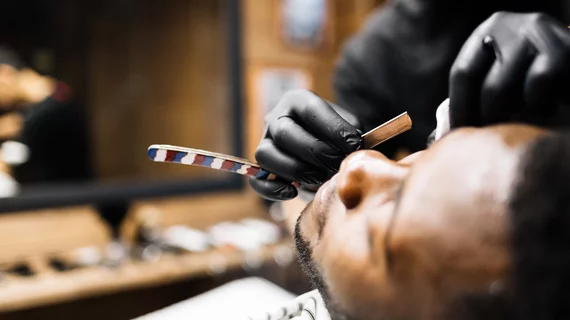The impressive blood pressure reductions seen among hypertensive black men participating in a barbershop-based intervention were sustained through one year, according to a follow-up study published Dec. 17 in Circulation.
The purpose of the study was to determine whether black men—a group that’s been disproportionately affected by high blood pressure and related adverse events—could achieve meaningful BP reductions when pharmacist-led specialty care was provided in black-owned barbershops, locations that often inspire loyal patronage in the African-American community.
Fifty-two different barbershops in the Los Angeles area participated, with half of the locations being randomized to the pharmacist-led intervention and the other half being randomized to serve as a control group. Participants at the intervention shops received monitoring and medication from pharmacists who traveled to those businesses, while the patients in the control group were encouraged by barbers to schedule appointments with their primary care physicians and engage in lifestyle modifications aimed at controlling blood pressure.
At one year, the average systolic blood pressure (SBP) fell by 28.6 mm Hg in the intervention group to 123.8 mm Hg, and by 7.2 mm Hg to 147.4 mm Hg in the control arm. Average drops in diastolic blood pressure were 14.5 mm Hg greater in the intervention group.
The researchers said the reductions in both systolic and diastolic BPs were “statistically indistinguishable” from the six-month results—despite pharmacists reducing the frequency of their visits between six and 12 months.
“Among black male barbershop patrons with uncontrolled hypertension, health promotion by barbers resulted in large and sustained BP reduction over 12 months when coupled with medication management by American Society of Hypertension-certified pharmacists,” Ciantel A. Blyler, PharmD, and colleagues wrote. “Broad-scale implementation research is both justified and warranted.”
The study cohort included 319 black men who had SBPs above 140 mm Hg at baseline. Average starting SBPs were 152.4 and 154.6 mm Hg in the intervention and control groups, respectively.
At one year of follow-up, every patient in the pharmacist-led intervention was taking antihypertensive medication, while only 65 percent of the control group was taking BP drugs.
“More intensive drug therapy with more combination regimens, more first-line BP drugs, and more long-acting drugs largely explain the enhanced BP reduction observed in our intervention group compared with standard treatment by community physicians,” the authors wrote. “In a departure from most guidelines that recommend thiazide-type diuretics and calcium channel blockers as first-line treatment for black men, our starting regimen of an angiotensin receptor blocker or angiotensin-converting enzyme inhibitor plus amlodipine was well tolerated and proved very effective, with only 50% of regimens requiring ≥3 drugs.”
Blyler et al. said several other factors may have also contributed to the effectiveness of the intervention. Bringing the specialty treatment to a barbershop may have provided a more convenient space to access these patients, who averaged a decade of patronage at their specific barbershops. In addition, barbers are generally trusted members of their community, which could have alleviated customers’ distrust of medical professionals in more conventional care settings.
The researchers said they’re assessing the cost-effectiveness of this intervention and also performing a pilot test in a different city with a different pharmacist-led team.
Considering pharmacists’ travel time to and from barbershops was one of the most time-consuming aspects of the trial, they noted telemedicine could be an effective way to maintain adherence after rapport has been established with initial in-person visits. However, that concept requires further study for this approach.
In a related editorial, Tulane University researchers Keith C. Ferdinand, MD, and Rachel M. Graham said factors specific to the Los Angeles-area participants must also be taken into account when considering whether to implement a barbershop-based intervention in other communities.
The long-term relationships participants had with their barbers was remarkable and may not be easily replicated elsewhere, the editorialists noted. Also, other black communities may be more socioeconomically disadvantaged than this one, as almost half had at least an associate’s degree and about 80 percent had health insurance—higher rates of both educational attainment and insurance coverage than for many southern communities.
“As a society, effective blood-pressure control in high-risk individuals with intensive antihypertensive medications is cost-saving and cost-effective in the long term, regardless of race/ethnicity, sex, socioeconomic status, or geography,” Ferdinand and Graham wrote. “The benefits of the recent extension from the (Los Angeles Barbershop) randomized trial must be weighed against its complexity, generalizability to diverse populations, and potentially high implementation costs.”

